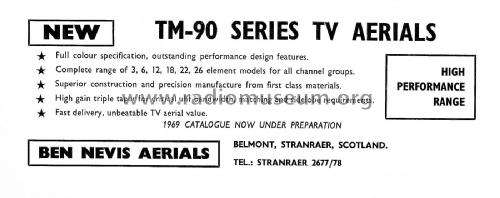Yagi Antenna TM-90 Series
Ben Nevis Aerials; Stranraer
- País
- Gran Bretaña (GB)
- Fabricante / Marca
- Ben Nevis Aerials; Stranraer
- Año
- 1967–1982
- Categoría
- Antenas o acopladores de antena
- Radiomuseum.org ID
- 355795
- Gama de ondas
- VHF/UHF (see notes for details)
- Tensión de funcionamiento
- No necesita alimentación
- Altavoz
- - - No hay salida de sonido.
- Material
- Materiales diversos
- de Radiomuseum.org
- Modelo: Yagi Antenna TM-90 Series - Ben Nevis Aerials; Stranraer
- Anotaciones
-
The TM-90 series was a family of Yagi-Uda antennas for domestic TV and VHF/FM radio reception manufactured by Ben Nevis Aerials in Stranraer, Scotland, from 1967 until 1982.
In view of the limited number of UK TV transmitters at that time, there was a demand from many viewers in Southwest Scotland for high-gain antennas that allowed them to receive transmissions from Northern Ireland. Compared with popular wideband UHF antennas that covered all UK TV channels from 21 to 68, greater gain was achieved by optimising each of the antennas for reception in one of 3 channel groups. In 1967 these were:
In Band IV (470 - 614 MHz):
- Group A: Channels 21-34, coded red
In Band V (614 - 854 MHz):
- Group B: Channels 39-51, coded yellow
- Group C: Channels 52-68, coded green
Minor changes to the upper and lower frequencies of some of these groups were made in 1969 and 1995. Group A was extended to include Channel 38 and Group B was extended to cover Channels 35 to 53. Later, much of Group C was reallocated to cellular services and the upper limit for Band B was reduced to Channel 48.
The antennas were designed using a DEC PDP-8 minicomputer, the calculations being based on a database of physical measurements of the phase velocity of long untapered periodic slow-wave structures with different element lengths and spacings. In view of the limited capacity of the core memory of the computer, it was programmed in assembly language. F/B ratio and bandwidth were improved by the use of the plate reflector (perforated to reduce weight and wind resistance) shown in the photo of the 18-element Group B antenna, while skeleton corner reflectors were used for the largest stacked arrays. For manufacturing efficiency, most of the directors of the antennas within each frequency group were the same length, the phase velocity body and end tapering being achieved by varying the element spacing alone. However, for the feed taper, some longer elements were required to achieve optimum coupling to the folded dipole. Final tuning was made on a test range using General Radio VHF/UHF Unit Oscillators as transmitters.
The Ben Nevis facility included a multi-head drilling machine for booms up to 4 metres long, as well as machines for bending and cutting aluminium alloy tubes, for pressing mast clamps and boom support brackets, and for the injection moulding of small plastic components such as director clips. The final assembly and checking of the antennas was done manually. While the antennas supported high winds, damage caused by large seabirds was not uncommon in coastal locations. The example pages of the first decimalised Ben Nevis price list, published in 1971, show that even the smallest components of the antennas, such as individual elements, insulator caps and folded dipoles, could be supplied as retail spare parts. Ruggedised versions of some of the antennas were made under contract to Trinity House for lighthouses around the coast of the UK. These used plastic-coated booms and elements to avoid salt corrosion and they were also supplied to P&O for use on their ships.
Although production at Ben Nevis Aerials ceased in 1982 on the retirement of the proprietor, Andrew Fleming, many antennas remained in service into the 21st century.
- Mencionado en
- -- Original prospect or advert (Electrical and Electronic Trading, 27 June 1968 and 17 January 1969)
- Autor
- Modelo creado por Bruce Taylor. Ver en "Modificar Ficha" los participantes posteriores.
- Otros modelos
-
Donde encontrará 1 modelos, 1 con imágenes y 0 con esquemas.
Ir al listado general de Ben Nevis Aerials; Stranraer
Colecciones
El modelo Yagi Antenna es parte de las colecciones de los siguientes miembros.









